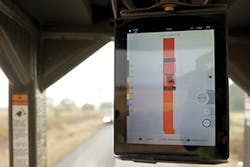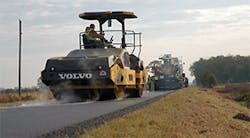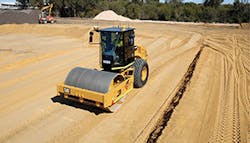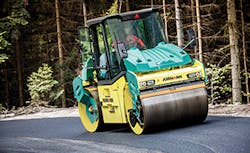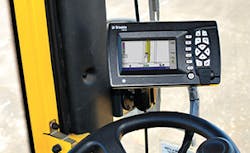Intelligent compaction encompasses a suite of technologies that are designed to help contractors meet density specifications on asphalt and soil compaction projects.
“Compaction measurement tools allow contractors to more accurately compact asphalt mats to specification density for their customers, while saving the contractors time and money by avoiding unnecessary additional passes. These tools help to prevent under compaction and over compaction, both having detrimental effects on mat quality and longevity,” says Bert Erdmann, product manager, heavy compaction, BOMAG Americas Inc.
Meeting density requirements is one of the largest challenges in a compaction application. It is also one of the major causes of premature failures of roads and highways.
“The key to achieving density targets on compaction projects is to establish a proper rolling pattern and to uniformly and consistently maintain it. After the first pass, especially when working at night, it’s not easy to see where the compactor has rolled,” says Mark Eckert, product manager for compaction at Volvo Construction Equipment North America. “Where did I stop my last pass? How far over was I? Without this technology, operators have to reference something on the side of the road—a telephone pole, tree, or bush—that can become quite hard. Therefore, roller patterns tend to overlap both from side to side and front to back.”
Intelligent compaction gives density results for the entire compacted area—not just a few core samples, so this information is very important to transportation agencies. With more frequency, state DOTs are regulating that intelligent compaction must be used on highway paving projects. The state of Minnesota, for example, now requires intelligent compaction on all highway projects of a certain size.
“Contractors will run into a DOT (Department of Transportation) specification where they have to provide compaction measurement values,” says Eckert. “That is becoming more common; it’s more important that density is achieved efficiently, and intelligent compaction is another tool that can give you the confidence that you are delivering a product that meets specification.”
Volvo Intelligent Compaction calculates density values.
What Is Intelligent Compaction?
Intelligent compaction, at its minimum, includes GPS, an accelerometer, and an interactive screen; some manufacturers offer even more data. GPS shows where the machine is at all times and allows for pass mapping and roller speed data. An accelerometer relays asphalt temperature data. The interactive screen shows data such as pass count, mat temperature, the compaction meter value (CMV), and more. With this data, the operator can take any kind of corrective action needed if any measurement is not within the desired range.
“CMV essentially uses an accelerometer to measure the mat response to being struck by the vibrating drum. The more prominent the response, the greater the stiffness of the soil,” says Bryan Downing, global sales consultant, paving, Caterpillar.
“The CMV will vary from machine to machine and OEM (original equipment manufacturer) to OEM. From the cab of the roller, we can’t measure density, but we can measure stiffness, which is an indicator of density,” says Kevin Garcia, paving segment manager for Trimble’s Civil Engineering and Construction Division. “As you make passes with the roller, you are driving out the air voids and getting a denser mat with each subsequent pass. As it gets denser, it becomes stiffer, so more energy from the drum vibration will bounce back into the machine. It’s like slapping your hand onto a pillow versus slapping your hand onto a table. Slapping the table hurts more, because the table didn’t absorb the energy so more energy goes back into your hand. The CMV will eventually plateau, and then you can have confidence that you have density.”
Wirtgen provides an ICMV (Intelligent Compaction Measurement Value); it measures the stiffness of the material as it gets compacted it by vibration, but it doesn’t relate how dense it is. Manufacturers of rollers use different algorithms to determine stiffness values. “When comparing stiffness values from one OEM machine to another, the values will not be the same because of the calculation differences from the accelerometer feedback, but they should follow the same pattern,” said Tim Kowalski, application support manager, Wirtgen America.
“Compaction measurement systems provide more information to the operator. At the simplest, the operator can use the compaction measurement systems to provide a target compaction value and then roll until the target is met. The system provides the real-time compaction value of the location it is on at any given time, but the operator does not have an overall picture of the uniformity and coverage of the site,” says Downing. “The greatest uniformity, quality, and efficiency come when a mapping system is added. Mapping helps the operator visualize the working area, but the key is to monitor the rate of increase in stiffness of the material—we call it ‘compaction growth.’ The operator watches to see how much the values of compaction measurement change pass-by-pass.”
“Data taken from sensors is put through our software; it will provide a CMV, however Volvo also has a way to calibrate the machine to provide a density of 92% or 94%, for example, which means either 8 or 6% air voids. That’s kind of unique to Volvo. Most companies just provide the CMV. We came out with Density Direct providing the density value is more accurate and more relevant information to the contractor,” says Eckert.
The Cat CS56B vibratory soil compactor comes with Intelligent Compaction.
Although all intelligent compaction systems achieve the same goal, they do so with some small but significant differences. BOMAG, for example, offers two measuring solutions for asphalt compaction: Economizer and Asphalt Manager 2 (AM2). “BOMAG Economizer is an intuitive, easy-to-operate system that measures asphalt stiffness,” says Erdmann. “As the roller makes its series of passes, asphalt stiffness increases and a higher number of indicator lights illuminate on the control panel display. Economizer provides immediate feedback to the operator of the level of compaction. When the number of lights stops increasing, optimum compaction has been achieved. The final light illuminating indicates potential over-compaction and provides the operator with immediate feedback to stop compacting this area to prevent over compaction.”
Erdman continues: “BOMAG AM2 is a more sophisticated compaction measurement system. This special roller includes a front vectoring vibrating drum—from full vertical to full horizontal—to proactivity prevent over-compaction of the asphalt mat. The operator can set the target EVIB value and the roller will automatically adjust the vibration angle as material stiffness increases and approaches the EVIB value. Similar to Economizer, AM2 EVIB values can be correlated to nuclear density gauge readings. As job conditions change either due to weather, base stability, or asphalt mat thickness, the operator can adjust the EVIBvalue up or down with the touch of a button.”
“In our HCQ (Hamm Compaction Quality) intelligent compaction system, we can map everything out, print it off, and show the customer exactly what was done, so they can take comfort that the mat is compacted to specification,” says Kowalski.
Volvo Density Direct monitors
Volvo puts an accelerometer on the drum of a soil compactor (or the rear drum of a double drum machine) to provide compaction information, and the company puts temperature sensors on the front and rear of the machine to provide mat surface temperatures. With temperature sensors, it can give you a reference that the material isn’t too cool or too hot by viewing mat temperature on the screen. You can put in minimums and maximums and it will highlight if it is cooler or hotter.
Volvo asphalt rollers also offer more flexibility when it comes to amplitude. While most rollers offer two settings—high and low—Volvo also offers eight amplitude settings. “Ultimately, the key to intelligent compaction technology is that it provides roller operators with real-time information they can utilize to achieve their rolling pattern and make adjustments when necessary. Let’s say you begin a project using number 4 amplitude. If the density number comes back a little lower than desired, you can increase amplitude to setting 5,” says Eckert. “With other dual amplitude machines, you either have to adjust the amplitude setting to high, which could damage the material, or make an extra pass.”
And, like other manufacturers, the company provides a pass mapping system. “When the compactor is moving, it displays each pass in a different color. Our system can be set up to map whether you have vibration on or vibration off. So, it gives contractors the confidence that they achieved their rolling pattern,” says Eckert.
“We offer the intelligent compaction Trimble CCS900 Compaction Control System for asphalt, soil, and landfill compactors,” says Garcia. “At its core, intelligent compaction was designed to manage pass count. Rollers aren’t lawn mowers; you can’t look back and see where you’ve been, so it can be difficult to know that you have achieved compaction. This technology helps monitor values, so the operator can know the pass count. Then you can add measurements such as temperature; we can run a temperature sensor on both the front and rear of the roller, so you know the temperature in the direction of travel. Achieving the correct temperature is important because asphalt outside of the appropriate temperature window will not achieve the expected density.
The Ammann line of ASC asphalt rollers feature Ammann Compaction Expert (ACE), a proprietary intelligent compaction system. Ammann has been developing intelligent compaction systems since the late ’90s when it launched its first generation of ACE.
Ammann describes ACE as an automatic measurement, control, and documentation system. As well, it can be supported with GPS mapping to provide data regarding the areas the compactor has covered. All measured values, such as the load-bearing capacity of the material, the number of passes, and the frequency and amplitude values, can be displayed for evaluation.
The compactors are available with two variations of the system. ACE Pro measures and evaluates ground characteristics and automatically adjusts the amplitude and frequency accordingly.
The Amman ARP 95 tandem drum roller measures ground characteristics.
A Better-Quality Product in Less Time
Intelligent compaction gives contractors the knowledge that they have delivered a product that meets specifications in the fewest passes possible. Eliminating passes has an enormous impact on productivity and profitability. Each pass that is avoided results in significant savings in fuel and labor, as well as less machine wear. “Intelligent compaction has been demonstrated to increase productivity by 15 to 35%,” says Kowalski. Some time-saving benefits include fewer passes, less work, and less rework.
Many roller operators tend to over compact in order to make sure that they don’t under compact, so knowing exactly where the roller has been and how many passes have been made will often decrease the number of passes needed while allowing for a more uniform mat. Using intelligent compaction also eliminates the need to take core samples and refill those areas. And, intelligent compaction allows you to address issues earlier because the operator can see the results of his or her work at the time it is being completed.
ACE enables the compactor to record the actual bearing capacity on each layer, revealing the location of non-compactable spots where material exchange is necessary. It helps ensure a homogenous compacted area and helps uncover trouble spots early in the process, when remedies are easiest and cost less.
“Intelligent compaction gives quality technicians another tool. They have their handheld compaction gauges and heat guns and test cores; with intelligent compaction, they have a roller that also provides all that information and more in real time,” says Eckert. All the data can be uploaded to a cloud so someone can, in real time or after the project is complete, examine all the data, such as pass count, roller speed, and asphalt temperature.
“Compaction measurement tools will help to deliver a better-finished product for customers, which helps to boost the contractor’s reputation for quality and can lead to more jobs,” says Erdmann. “On projects paying bonuses for reaching target densities, Economizer and AM2 can help to put more money in the contractor’s pocket. These tools let the operator know when optimum compaction is achieved to give him/her the confidence that spec densities are met throughout the mat.”
“Intelligent compaction improves night work because the operator doesn’t have to find in poor lighting points of reference to mark where the roller has been; the operator can simply look at the screen inside the cab and see the pass count they are on based on the color chart for pass count,” says Kowalski.
The Trimble CS900 Compaction Control System for asphalt, soil, and landfill
Contractors Have to Want to Use It
Although intelligent compaction has been around for nearly two decades, and there are significant benefits to be realized, adoption of the technology is still pretty slow.
“There is a little reluctance to use the new technology because contractors are not used to it. When they start using it, they start seeing the advantages. They see how well it makes them do a better job,” says Tim Kowalski. According to Kowalski, in 2017, there were more than 450 projects that used intelligent compaction, but 10 years earlier, only four projects had used intelligent compaction.
“Technology makes quality work simple; but it can change the fundamental approach to work with increasing magnitudes of process change, and that often makes contractors cautious. For example, traditionally, the compaction operator either rolls an area a specified amount of times (method spec), or they roll it until it ‘feels right,’ then they call for testing. Both methods are extremely simple, but they are often inefficient and can lead to non-uniform results,” says Downing. “There are early adopters for any new technology; but customer utilization is highly dependent on agency specification, which often leads to contractors being introduced to the technology for the first time. Once they have used the technology, they see how it contributes to lower costs and higher quality work, leading to more use when the technology is not specified,” says Downing.
“Hamm machines make it easier to use the equipment effectively, so they can do a better job,” says Kowalski. “Our machines don’t have 10 buttons that each does one thing, we have one button that does 10 things. Machines used to have complex controls. Now, it’s almost like sitting down and playing an Xbox. Contractors have to want to use the equipment. Wanting to use the equipment is what will make them successful. At Hamm, we want to keep things simple. Our Easy Drive system is on all of our machines, so if you know how to operate one, you can operate them all. Plus, the HCQ system is Windows-based, with only a few simple options, so it is easy for contractors to set up the way they want and use.”
Ammann also realizes that systems must be operator friendly in order to be adopted. The operation of ACE is managed via one simple structured display. The system guides the operator, almost like he or she is using a cash machine. In operation mode, the display focuses on the most relevant information and leads the operator by indicating the optimal rolling speed.
“Although sales increase each year, adoption is still quite low in North America where this technology is in its infancy,” says Garcia. “The number of machines in North America with intelligent compaction is in the thousands, but that is still a small percentage of the total number of machines. Most of the sales are driven by specifications. DOTs are requiring it on a lot of projects to monitor the work, so many contractors are adopting it because it is a job requirement. In Europe, it’s almost never driven by specifications, it’s almost always contractor-adopted. In the next 10 years, this technology will be standard.”
“We put the intelligent compaction on machines for which we see demand, so we put it on our large platform double drum machines, which are our 10-ton weight class and higher, such as the DD105 and the DD110, which have a drum width of 66 inches,” says Eckert. “And then we step up to even larger highway class rollers; these machines are more likely to perform mainline paving versus commercial sites, parking lots, and patchwork. I’m not saying you won’t find parking lot projects with a density spec, but the focus on motoring safety puts emphasis on density and smoothness, increasing the utilization of intelligent compaction systems on highway paving projects.”
Conclusion
Adopting intelligent compaction impacts how contractors manage their operations.
“As the company becomes more familiar with compaction measuring systems like Economizer and AM2, we typically see them become more quality conscious. They now have the tools to help increase mat quality, while at the same time, they save time and money by eliminating additional passes,” says Erdmann. “Without these tools, the operator will not be sure if spec densities throughout the mat are achieved until after the fact with nuclear density measurement and may make unnecessary extra passes. Additionally, the operator will have to manually shoot the mat with a temperature sensor to know when to compact and when to get off the mat.
“The operator inherently wants to do a good job,” says Garcia. “We conducted an experiment. We put a seasoned operator on a machine with intelligent compaction, but covered up the screen, so he couldn’t read any of the data. He just completed his work as he normally does for two shifts. Then we uncovered the screen and let him work for two more shifts. Then we compared the data. I think most of us in the experiment expected to find large areas that were missed, and in fact, we found the opposite. Operators were exceeding pass count because they had forgotten which pass they were on and completed more passes to be on the safe side. The result of over compaction is a premature failure, and we were able to help this contractor cover more ground in less time and they saw a 23% increase in productivity.”
If you don’t hit density, you risk doing the whole project over again, removing the material and replacing it, which is extremely expensive. Intelligent compaction allows contractors to make adjustments along the way, achieve density, and deliver a pavement that will be in good condition for a long time.